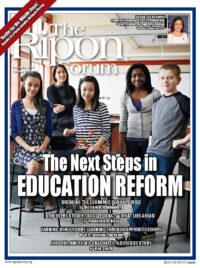
In December, after years of false starts, Congress passed the Every Student Succeeds Act (ESSA). The new law rewrote the 2001 No Child Left Behind Act (NCLB) and served as a long-overdue course correction to an era of steady federal encroachment into K-12 education. While hardly ideal, the new law gets the big things mostly right and points federal policy in a more promising direction.
A bit of history is helpful. In 1965, as part of President Lyndon Johnson’s War on Poverty, Congress passed the Elementary and Secondary Education Act (ESEA). ESEA sought to boost the achievement of disadvantaged students. Yet ESEA failed to deliver on that promise and no one knew whether federal money was actually helping.
In 2001, eager to ensure that federal funds were being used effectively and that vulnerable children would no longer be overlooked, President George W. Bush and key congressional Democrats revamped ESEA. The result was NCLB, a well-intentioned but flawed mash-up. It sought to do three big things, all important, but not all well-suited to federal efforts.
- One was to promote transparency by requiring states to regularly test students in reading and math and to disaggregate and publicly report the results for individual schools and school systems.
- The second was to set forth a federal framework for judging school performance, primarily in terms of the reading and math scores of different demographic groups. States were required to set steadily increasing goals for the proficiency of each group.
- The third was to make schools improve by setting forth a mandated series of mostly ineffectual interventions for low-performing schools.
Ultimately, NCLB proved to be remarkably prescriptive about how states would measure school performance and what states would do to schools deemed “in need of improvement.” Absurdly, NCLB required that 100% of the nation’s children be “proficient” in reading and math by 2014, with mandated consequences for schools that missed the bar.
Crafting a national law that can apply to 100,000 schools in 50 states makes for clumsy metrics and whimsical, pie-in-the-sky targets.
Washington proved to be fairly good at transparency — at requiring states to regularly test, disaggregate results, and report performance. By requiring states to test in the same subjects and grades, Congress created a framework for public transparency. When it came to judging performance and trying to make schools improve, however, Uncle Sam was ill-equipped for the job. Crafting a national law that can apply to 100,000 schools in 50 states makes for clumsy metrics and whimsical, pie-in-the-sky targets.
Indeed, NCLB’s unfortunate legacy included allowing the Obama administration to dictate K-12 policy via quid pro quo waivers granted to states desperate to escape NCLB’s 100% proficiency mandate — or else label most of their public schools as failures. The Secretary of Education released dozens of states from NCLB’s fantasy targets if — and only if — they promised to pursue Obama priorities. In this way, the Obama administration helped turn the Common Core into a divisive distraction and poisoned new teacher evaluation systems by forcing states to hurriedly implement not-ready-for-primetime schemes on a politically determined timetable.
ESSA was intended to clean up the various messes that came in NCLB’s wake: a capricious accountability system, a nonsensical series of mandates around school improvement, an unhealthy obsession with testing, and states that felt blackmailed by the U.S. Department of Education. ESSA did a remarkable job of getting most of the big things right.
ESSA did a far better job than NCLB of separating the baby from the bathwater. ESSA retains NCLB’s requirement that states test once a year in reading and math (in grades 3-8 and once in high school) and science (once in elementary, middle, and high school).
Meanwhile, ESSA gets Washington (mostly) out of the business of judging whether schools are failing and (wholly) out of the business of mandating school improvement strategies.
The result should help to cool test mania by allowing states to develop accountability systems that are less reliant on once-a-year reading and math scores. It requires that state accountability systems continue to base more than half of school ratings on achievement measures, but permits states to incorporate other measures as they see fit.
In response to the Obama administration’s unprecedented and legally dubious use of quid pro quo waivers, ESSA imposed a raft of new prohibitions on the U.S. Department of Education’s ability to manipulate states or involve itself in their affairs.
ESSA also included big wins for charter schooling and public school choice, with charter schools getting the law’s only notable funding increase and the creation of a pilot program that allows up to fifty school districts leeway to use federal funds as part of a “weighted student funding” model.
While ESSA got these big things mostly right, even those of us who regard it as a clear conservative triumph have noted that it’s no more than three-quarters of a loaf.
While ESSA got these big things mostly right, even those of us who regard it as a clear conservative triumph have noted that it’s no more than three-quarters of a loaf. There is still plenty of work yet to do. Five opportunities for improvement particularly stand out:
First, while ESSA pares back NCLB’s overwrought accountability and intervention mandates, its 1,000+ pages leave far too much room for bureaucratic mischief. Its language is murky enough that the law’s clear restrictions on federal involvement still might be transformed into a troubling invitation to bureaucratic mischief.
Second, closely related, is that how ESSA is implemented is what will ultimately matter. All the law’s clear prohibitions on federal involvement in state standards, accountability systems, or testing still depend on faithful execution. Ensuring that the statutory language is obeyed and put into practice is critical work that requires legislative knowledge and diligence.
Third, conservatives had to make serious compromises to get the deal done. The most significant of these was on school choice, where they threw in the towel on efforts to allow low-income students to use federal Title I funds at the public or private school of their choice. A viable compromise is to modify the law so that it simply allows states to expand school choice in this manner.
Fourth, a critical and appropriate federal role when it comes to K-12 schooling is the support of research. This is a case of a classic public good, but one where the U.S. has historically underinvested — with Washington spending on education research barely 1% of what the nation spends on medical research. While research is better addressed under the Education Sciences Research Act than under ESSA, investing in quality research is an essential part of getting the post-ESSA federal role right.
Fifth, smart federal education policy is rooted in the recognition that federal mandates are moderately effective when simply requiring that states do them is enough. For instance, requiring states to administer annual tests and report the results is pretty straightforward. It’s an easy requirement to enforce, and therefore entails little red tape or intrusion. When it comes to things like accountability systems and school improvement, however, whether they’re done matters infinitely less than how they’re done. Here federal efforts have yielded incoherent mandates, bureaucratic sprawl, and one-size-fits-all dictates, with lots of consequent foot-dragging and ineptitude.
Fighting to have Washington do more when it comes to schooling is not the same thing as fighting for better schools. In the ESSA era, it’s crucial to know where Washington can help and where it can’t — and to insist that policymakers lead accordingly.
Frederick M. Hess is director of education policy studies at the American Enterprise Institute. His books include Carrots, Sticks, and the Bully Pulpit: Lessons from a Half-Century of Federal Efforts to Improve America’s Schools.




